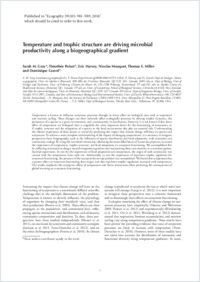Temperature and trophic structure are driving microbial productivity along a biogeographical gradient
- Gray, Sarah M. Dépt de biologie, chimie et géographie, Univ. du Québec à Rimouski, Canada - Dept of Biology, Unit of Ecology and Evolution, Univ. of Fribourg, Switzerland
- Poisot, Timothée Dépt de biologie, chimie et géographie, Univ. du Québec à Rimouski, Canada - Québec Centre for Biodiversity Sciences, QC, Canada - Univ. of Canterbury, School of Biological Sciences, Christchurch, New Zealand - Dépt de sciences biologiques, Univ. de Montréal, QC, Canada
- Harvey, Eric Dépt de biologie, chimie et géographie, Univ. du Québec à Rimouski, Canada - Dept of Integrative Biology, Univ. of Guelph, Canada - Inst. of Evolutionary Biology and Environmental Studies, Univ. of Zurich, Switzerland
- Mouquet, Nicolas Inst. des Sciences de l’évolution, CNRS-UMR 5554, Univ. Montpellier II, France
- Miller, Thomas E. Dept of Biological Science, Florida State Univ., USA
- Gravel, Dominique Dépt de biologie, chimie et géographie, Univ. du Québec à Rimouski, Canada - Québec Centre for Biodiversity Sciences, QC, Canada
-
2016
Published in:
- Ecography. - 2016, vol. 39, no. 10, p. 981–989
English
Temperature is known to influence ecosystem processes through its direct effect on biological rates such as respiration and nutrient cycling. These changes can then indirectly affect ecologically processes by altering trophic dynamics, the persistence of a species in a given environment, and, consequently, its distribution. However, it is not known if this direct effect of temperature on biological rates is singularly the most important factor for the functioning of ecosystems, or if trophic structure and the adaptation of a species to the local environment also play an essential role. Understanding the relative importance of these factors is crucial for predicting the impact that climate change will have on species and ecosystems. To achieve a more complete understanding of the impact of changing temperatures, it is necessary to integrate perspectives from biogeography, such as the influences of species distribution and local adaptation, with ecosystem and community ecology. By using the microbial community inhabiting the water-filled leaves of Sarracenia purpurea, we tested the importance of temperature, trophic structure, and local adaptation on ecosystem functioning. We accomplished this by collecting communities along a natural temperature gradient and maintaining these communities in a common garden, factorial experiment. To test for the importance of local adaptation and temperature, the origin of each community was crossed with the temperature from each site. Additionally, to test the importance of top-down trophic regulation for ecosystem functioning, the presence of the mosquito larvae top predator was manipulated. We found that temperature has a greater effect on ecosystem functioning than origin, and that top-down trophic regulation increased with temperature. Our results emphasize the synergistic effects of temperature and biotic interactions when predicting the consequences of global warming on ecosystem functioning.
- Faculty
- Faculté des sciences et de médecine
- Department
- Département de Biologie
- Language
-
- English
- Classification
- Biological sciences
- License
- License undefined
- Identifiers
-
- RERO DOC 278411
- DOI 10.1111/ecog.01748
- Persistent URL
- https://folia.unifr.ch/unifr/documents/305326
Statistics
Document views: 82
File downloads:
- gra_tts.pdf: 137
